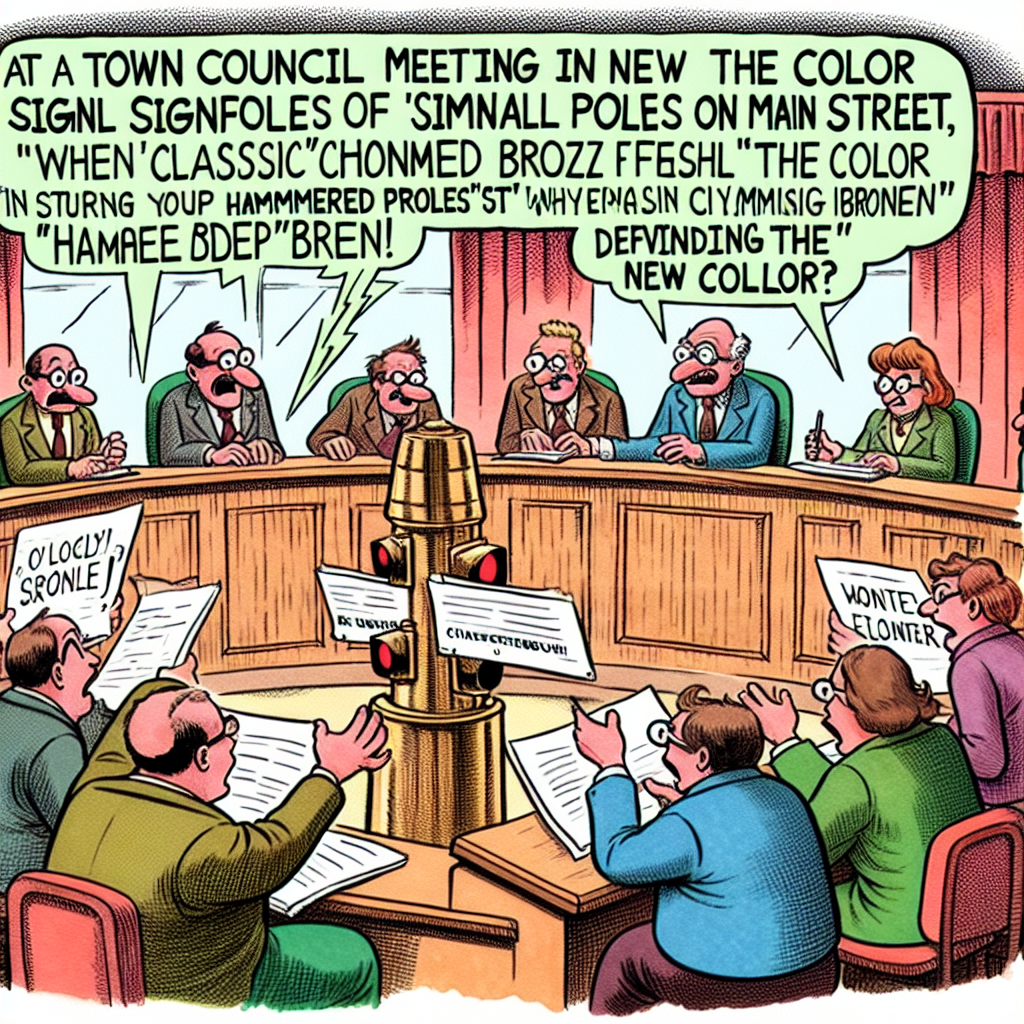**"The Hammered Bronze Poles: A Microcosm of Chesterburgh’s Identity and Democratic Dialectics"**

“There are no facts, only interpretations.” — Friedrich Nietzsche
It is a curious and somewhat Sisyphean affair that the township of Chesterburgh, a locus less renowned for its sweeping vistas than for its intricacies of pedestrian governance, has recently found itself embroiled in a debate of ostensibly Sisyphean triviality: the color of the newly installed traffic signal poles along Main Street. What might, at first blush, seem an exercise in chromatic preference unfolds under scrutiny as an allegory of local power dynamics, aesthetic philosophy, and the ever-encroaching colonization of public spaces by regulatory zealotry.
Last Tuesday, at precisely 7:03 p.m., the town council convened a special session to address a petition put forth by the “Chesterburgh Coalition for Civic Coherence” (CCCC), a group one might generously describe as fastidious, if not outright constipated in their approach to municipal decoration. The petitioners articulated a fundamentally normative stance: that the freshly procured traffic poles, currently swathed in a putative “hammered bronze” finish, violate an unwritten visual covenant that mandates the use of “classic Chesterburgh green” on all street furniture. Here one must pause to consider the ontological implications of color itself; whether “Chesterburgh green” is an objective hue or a shared hallucination permitted by social agreement. Indeed, if one accepts Wittgenstein’s dictum that language is a social fabric, then to dispute the color of a pole is to dispute the grammar of our public space.
The genesis of this chromatic controversy traces back to the town’s modest, if inherently fraught, budgetary constraints. In an effort to amalgamate efficiency with aesthetic uniformity, the Public Works Department outsourced the manufacturing of these poles to a vendor specializing in what might be called “heritage-industrial fusion.” The poles are designed to resist climatic vicissitudes ranging from mild frost to the occasional unseasonal downpour, but apparently their visual impact was less diligently surveyed at the conceptual outset. As such, the bronze finish—with its subtle interplay of copper and earth tones—has proven to be a mnemonic irritant for many long-time Chesterburgh residents, invoking a visceral, if indefinable, sense of aesthetic discordance.
However, an undercurrent of dissent runs deeper than mere irritable nostalgia or cromatic spats. The debate highlights a latent ethical quandary that meticulously dissects the tenets of municipal governance: To what extent should local government capitulate to the whims of vocal minorities in matters where public utility and subjective taste collide? The council’s mayor, a gentleman with commendable patience but an unfortunate penchant for obfuscation, suggested during the meeting that the poles’ color could be “considered a statement of evolving Chesterburgh identity,” a phrase that sent a palpable shiver through the assembled populace. One cannot help but parse this as an invocation of what Rosa Luxemburg might have termed the “democratic dialectic,” wherein the voice of tradition must confront the inevitability of change, but not without vigilant scrutiny.
Neatly interleaved within this debate emerged the auxiliary complication of cost. The “Chesterburgh Coalition for Civic Coherence” proposed an expensive repaint to rectify the transgression, estimated to cost nearly five thousand dollars, a sum that, if allocated toward pothole repair or school program funding, might arguably serve the community’s welfare with greater efficacy. Here again, the ethical dimensions proliferate: Is the aesthetic rectification of a limited number of poles a prudent fiscal expenditure in a town grappling with the kind of budget spreadsheets that could induce Baudr
